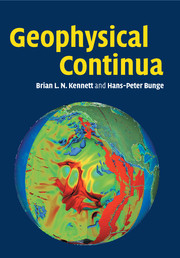Book contents
- Frontmatter
- Contents
- Preface
- 1 Introduction
- PART I CONTINUUM MECHANICS IN GEOPHYSICS
- PART II EARTH DEFORMATION
- 9 From the Atomic Scale to the Continuum
- 10 Geological Deformation
- 11 Seismology and Earth Structure
- 12 Lithospheric Deformation
- 13 The Influence of Rheology: Asthenosphere to the Deep Mantle
- 14 Mantle Convection
- 15 The Core and the Earth's Dynamo
- Appendix: Table of Notation
- Bibliography
- Index
12 - Lithospheric Deformation
from PART II - EARTH DEFORMATION
Published online by Cambridge University Press: 17 March 2011
- Frontmatter
- Contents
- Preface
- 1 Introduction
- PART I CONTINUUM MECHANICS IN GEOPHYSICS
- PART II EARTH DEFORMATION
- 9 From the Atomic Scale to the Continuum
- 10 Geological Deformation
- 11 Seismology and Earth Structure
- 12 Lithospheric Deformation
- 13 The Influence of Rheology: Asthenosphere to the Deep Mantle
- 14 Mantle Convection
- 15 The Core and the Earth's Dynamo
- Appendix: Table of Notation
- Bibliography
- Index
Summary
Definitions of the lithosphere
The concept of a lithosphere arises from the presence of a zone of strength near the Earth's surface that is capable of transmitting and resisting stress. A consequence of the complex rheology of the Earth is that the apparent thickness of this zone becomes smaller as the time scale of the processes being considered becomes longer. This has lead to a variety of definitions of lithosphere, based on particular classes of observations, that are not necessarily mutually compatible.
We can think of the mechanical lithosphere as representing the outer part of the Earth where stress can be transmitted over geological time scales. This is linked to, but not identical with, the thermal lithosphere, which is that region where thermal energy is largely transferred by heat conduction (Figure 12.1).
In seismological studies the lithosphere is commonly taken to be associated with the region of elevated seismic wavespeeds (the “lid”), with a base assigned either in the region of maximal vertical velocity gradient, or on entry into a zone of lowered shear wavespeed. Estimates of the temperature distribution associated with seismic wavespeed (e.g., McKenzie, Jackson & Priestley, 2005) suggest that this occurs in the same neighbourhood as the thermal transition (Figure 12.1).
- Type
- Chapter
- Information
- Geophysical ContinuaDeformation in the Earth's Interior, pp. 257 - 293Publisher: Cambridge University PressPrint publication year: 2008



